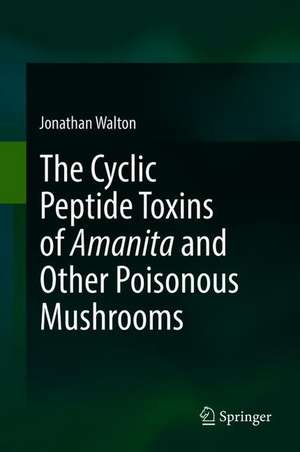The Cyclic Peptide Toxins of Amanita and Other Poisonous Mushrooms
Autor Jonathan Waltonen Limba Engleză Hardback – 24 mai 2018
This book is a complete top-to-bottom revision of Wieland’s 1986 book. The material covers history, chemistry, and biology with equal thoroughness. It should be of interest to natural products chemists and biologists, professional and amateur mycologists, and toxicologists.
The three scientific fields that are most relevant to the book are natural products chemistry, mycology, and fungal molecular genetics. Dr. Walton is an expert in all three. To maximize the broad utility and appeal of the book, care has been taken to define all technical terms specific to a particular discipline, so that, for example, mycologists will be able to understand the relevant chemistry, and chemists will be able to understand the relevant fungal biology.
| Toate formatele și edițiile | Preț | Express |
|---|---|---|
| Paperback (1) | 942.76 lei 6-8 săpt. | |
| Springer International Publishing – 21 dec 2018 | 942.76 lei 6-8 săpt. | |
| Hardback (1) | 948.79 lei 6-8 săpt. | |
| Springer International Publishing – 24 mai 2018 | 948.79 lei 6-8 săpt. |
Preț: 948.79 lei
Preț vechi: 1157.06 lei
-18% Nou
Puncte Express: 1423
Preț estimativ în valută:
181.58€ • 188.87$ • 149.90£
181.58€ • 188.87$ • 149.90£
Carte tipărită la comandă
Livrare economică 15-29 aprilie
Preluare comenzi: 021 569.72.76
Specificații
ISBN-13: 9783319768212
ISBN-10: 3319768212
Pagini: 290
Ilustrații: XIII, 245 p. 78 illus., 62 illus. in color.
Dimensiuni: 155 x 235 mm
Greutate: 0.54 kg
Ediția:1st ed. 2018
Editura: Springer International Publishing
Colecția Springer
Locul publicării:Cham, Switzerland
ISBN-10: 3319768212
Pagini: 290
Ilustrații: XIII, 245 p. 78 illus., 62 illus. in color.
Dimensiuni: 155 x 235 mm
Greutate: 0.54 kg
Ediția:1st ed. 2018
Editura: Springer International Publishing
Colecția Springer
Locul publicării:Cham, Switzerland
Cuprins
Introduction.- Chemistry of the Amanita Peptide Toxins.- Distribution and Taxonomic Variation in the Amanita Cyclic Peptide Toxins.- Biosynthesis of the Amanita cyclic peptide toxins.- Biological Activities of the Amanita Peptide Toxins.- Ecology and Evolution of the Amanita Cyclic Peptide Toxins.- Medical and Biotechnological Aspects.- Future Outlook.
Notă biografică
Jonathan Walton was raised in upstate New York and the Bay Area of California. He attended high school in Ojai, California, and graduated from the University of California, Santa Cruz, in 1975. He received an MS degree in plant pathology from Cornell University (1978) and a PhD in biological sciences from Stanford University (1982). He was a NATO postdoctoral fellow at the University of Rome “La Sapienza” and worked at the ARCO Plant Cell Research Institute in Dublin, California. Since 1987 he has been a professor of plant biology at Michigan State University in the Department of Energy Plant Research Laboratory. In 1993 he spent a sabbatical year at the University of California, Berkeley. He has published research on fungal toxins and their role in plant pathogenesis, the mechanisms of plant disease resistance, cell wall biosynthesis, herbicide safeners, enzymes for biomass conversion, and cyclic peptides from fungi.
Textul de pe ultima copertă
Poisonous mushrooms have fascinated scientists and laypersons alike for thousands of years. Almost all mushroom fatalities are due to the genus Amanita, whose poetic common names (death cap, destroying angel) attest to their lethality. In his classic 1986 book, Theodor Wieland covered the state of our knowledge about the chemistry and biochemistry of the toxins of Amanita mushrooms up until that time, with a particular focus on the decades of chemical research by him and the Wieland dynasty (including his father, brother, brother-in-law, and cousin). Wieland’s book is now mainly of historical interest, with its exhaustive overview of the early chemical studies done without benefit of methods taken for granted by modern chemists.
This book is a complete top-to-bottom revision of Wieland’s 1986 book. The material covers history, chemistry, and biology with equal thoroughness. It should be of interest to natural products chemists and biologists, professional and amateur mycologists, and toxicologists.
The three scientific fields that are most relevant to the book are natural products chemistry, mycology, and fungal molecular genetics. Dr. Walton is an expert in all three. To maximize the broad utility and appeal of the book, care has been taken to define all technical terms specific to a particular discipline, so that, for example, mycologists will be able to understand the relevant chemistry, and chemists will be able to understand the relevant fungal biology.
Caracteristici
First comprehensive volume on Amanita Detailed discussion of peptide toxins of Amanita Coverage of other poisonous mushrooms and their chemistry
